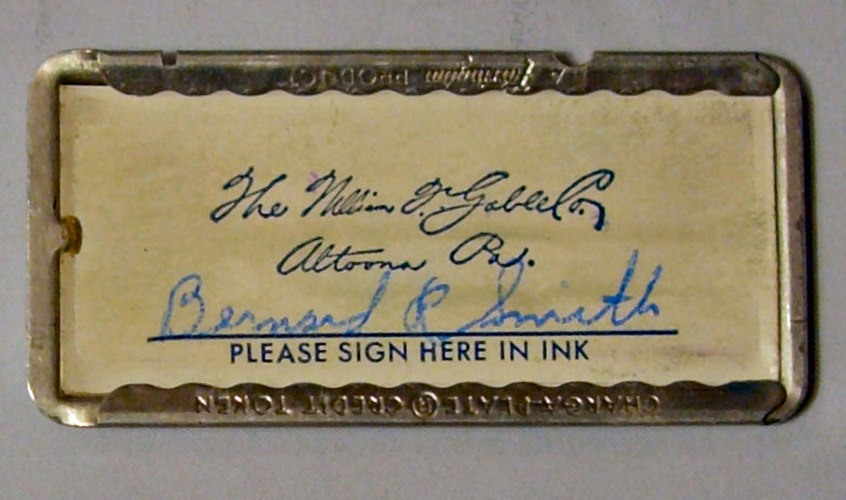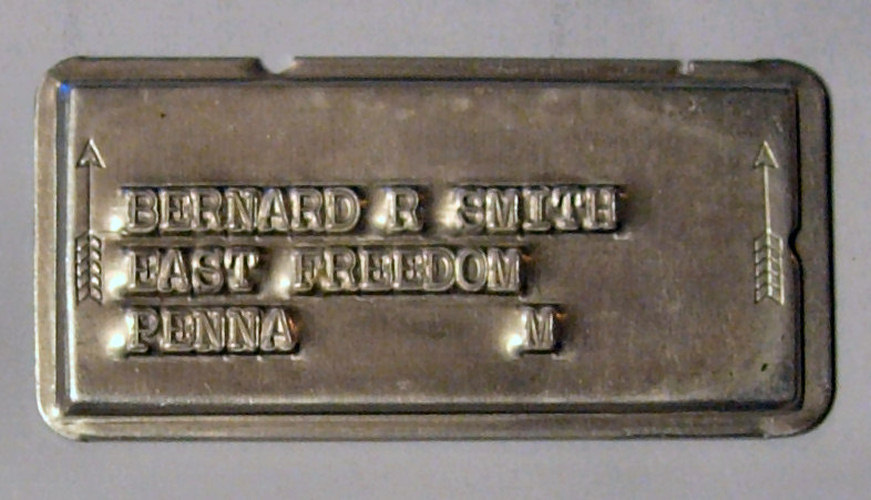


![]() The original purpose of this blog was to present objects related to the Colonial and American Revolutionary War periods, and explain their use and history. For the most part, I've tried to adhere to those original intentions. But, from time to time, I have deviated from the original time periods and written posts about objects of more recent age. This is going to be one of those again.
The original purpose of this blog was to present objects related to the Colonial and American Revolutionary War periods, and explain their use and history. For the most part, I've tried to adhere to those original intentions. But, from time to time, I have deviated from the original time periods and written posts about objects of more recent age. This is going to be one of those again.
![]() Exhibited above is an object that belonged to my father, Bernard R. Smith. It consists of a piece of metal, measuring 1-1/8" by 2-3/8" The piece of metal encloses, on one side, a piece of paper stamped with the name and location: The William F. Gable Co., Altoona, PA. Below that was a line on which my father signed his name.
Exhibited above is an object that belonged to my father, Bernard R. Smith. It consists of a piece of metal, measuring 1-1/8" by 2-3/8" The piece of metal encloses, on one side, a piece of paper stamped with the name and location: The William F. Gable Co., Altoona, PA. Below that was a line on which my father signed his name.
![]() The backside of the object reveals that my dad's name and address were emboss-stamped into the metal. Two arrows point in the direction above my father's name.
The backside of the object reveals that my dad's name and address were emboss-stamped into the metal. Two arrows point in the direction above my father's name.

![]() So what could this thing have been used for? Engraved on the edge of the small metal plate, on the side with the paper signed by my father, are the words: Charga Plate Credit Token. That should reveal the purpose of this object.
So what could this thing have been used for? Engraved on the edge of the small metal plate, on the side with the paper signed by my father, are the words: Charga Plate Credit Token. That should reveal the purpose of this object.
![]() As early as the Renaissance in Europe, forms of credit were being extended by artisans and merchants to customers. It was probably discovered that it was more beneficial to the merchant to sell their goods by credit rather than being passed up by customers who could not make the purchase at the time. As the American Colonies emerged and progressed on the North American continent, and on into the Nineteenth Century, merchants continued the practice of extending credit to their customers. Surviving to the present day are journals in which local merchants would record, by hand, their customers' credit transaction records. A common phrase heard by merchants was "please put it on my account." And so they would open the journal to the customer's record and tally the purchase. In the 1950s and 1960s, in America, and perhaps in other parts of the world, companies such as the 'department' store, The William F. Gable Company located in Altoona, PA, started moving from a handwritten journal to mechanically processed records.
As early as the Renaissance in Europe, forms of credit were being extended by artisans and merchants to customers. It was probably discovered that it was more beneficial to the merchant to sell their goods by credit rather than being passed up by customers who could not make the purchase at the time. As the American Colonies emerged and progressed on the North American continent, and on into the Nineteenth Century, merchants continued the practice of extending credit to their customers. Surviving to the present day are journals in which local merchants would record, by hand, their customers' credit transaction records. A common phrase heard by merchants was "please put it on my account." And so they would open the journal to the customer's record and tally the purchase. In the 1950s and 1960s, in America, and perhaps in other parts of the world, companies such as the 'department' store, The William F. Gable Company located in Altoona, PA, started moving from a handwritten journal to mechanically processed records.
![]() The object that is the subject of this post is evidence of the earliest form of credit card ~ used in the mechanical process of documenting the transaction in which a merchant would extend credit to the customer. This small card was kept by the customer: my father, Bernard R. Smith. When he wanted to purchase a commodity at The William F. Gable Company, but didn't have the ready cash to do so, he would present this little metal card to the clerk. The clerk would place the card, backside upward, in the proper slot of a special 'printing' machine. Overtop the card would be placed a paper form, which was actually a combination of a slip of paper and a piece of carbon paper (paper coated on one side ~ the side facing the plain paper ~ with a film of carbon-based ink). A handle on the machine would then be passed back and forth across the paper slips and the small metal credit card. Pressure from the handle would push down on the paper and carbon paper, causing the embossed letters of the metal credit card to be pressed into the paper/carbon paper slip. Functioning like a miniature printing press, the impression on the card would be 'printed' onto the paper slip. The clerk, with a quick back and forth motion, would imprint the customer's name and address onto the 'sales slip.'
The object that is the subject of this post is evidence of the earliest form of credit card ~ used in the mechanical process of documenting the transaction in which a merchant would extend credit to the customer. This small card was kept by the customer: my father, Bernard R. Smith. When he wanted to purchase a commodity at The William F. Gable Company, but didn't have the ready cash to do so, he would present this little metal card to the clerk. The clerk would place the card, backside upward, in the proper slot of a special 'printing' machine. Overtop the card would be placed a paper form, which was actually a combination of a slip of paper and a piece of carbon paper (paper coated on one side ~ the side facing the plain paper ~ with a film of carbon-based ink). A handle on the machine would then be passed back and forth across the paper slips and the small metal credit card. Pressure from the handle would push down on the paper and carbon paper, causing the embossed letters of the metal credit card to be pressed into the paper/carbon paper slip. Functioning like a miniature printing press, the impression on the card would be 'printed' onto the paper slip. The clerk, with a quick back and forth motion, would imprint the customer's name and address onto the 'sales slip.'
![]() Unlike today's credit cards, there was no magnetic strip to trigger the 'impression' of the customer's name and address, and that little printing press machine eventually was transformed into an electronic reader with a slot through which the card is passed. And not only is that a benefit of convenience: no longer is there any carbon paper to smudge and smear onto the clerk's fingers.
Unlike today's credit cards, there was no magnetic strip to trigger the 'impression' of the customer's name and address, and that little printing press machine eventually was transformed into an electronic reader with a slot through which the card is passed. And not only is that a benefit of convenience: no longer is there any carbon paper to smudge and smear onto the clerk's fingers.
